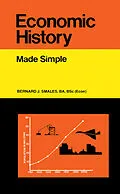Economic History: Made Simple traces Great Britain's economic history starting from about 1760 onwards. It also assesses the impact of technological change on people's lives. The book is organized into four sections covering different periods. Section I deals with emergence of the first industrial nation from 1760-1830. Section II focuses on the 1830-1914 period, when Britain was undergoing the transition from being a primarily agricultural and commercial economy into the first modern industrial state in the world. Section III discusses the 1914-39 period, which saw the First World War, followed by a boom lasting until 1920 and afterwards a depression of considerable duration. Section IV discusses Britain's economic and social development since 1939, covering topics such as the impact of the Second World War, and the post-war social, economic, and industrial policies.
This book should be useful to any students of economics who wish to explore the realities of economic life in historical perspective. It will also provide sound background reference for more elementary studies as well as being of value to readers seeking a greater understanding of the world in which they live.
Inhalt
Preface
Acknowledgments
Section One: The Emergence of the First Industrial Nation, 1760-1830
1 Introduction
What is Economic History?
The Concept of an Industrial Revolution
Rostow's Theory of Economic Growth
The Philosophical Rationale for Sustained Economic Growth
Suggested Further Reading
Exercises
Summary
2 The Prerequisites for Sustained Economic Growth
Favorable Background Conditions
Availability of Capital
Growth of Population
The Agrarian Revolution
Availability of Essential Raw Materials
Improvements in Transport
The Growth of Markets
Suggested Further Reading
Exercises
Summary
3 The Growth of Industry
The Influence of the State on Economic Development
The Pioneers of Industrialism
New Technology
Development of the Basic Industries
Suggested Further Reading
Exercises
Summary
4 War and the Industrial Revolution
The Post-War Distress
Suggested Further Reading
Exercises
Summary
5 The Human Results of the Industrial Revolution
Mobility of Labor
The Rise of the Industrial Town and the Growth of the Factory System
The Beginnings of Working-Class Organization
The Development of the Poor Law up to 1834
Standards of Living
Suggested Further Reading
Exercises
Summary
Section Two: Britain as the Workshop of the World, 1830-1914
6 Population Growth
The Population Cycle
Birth Rates
Death Rates
External Migration
Suggested Further Reading
Exercises
Summary
7 The Revolution in Transport
Railways
Shipping
Suggested Further Reading
Exercises
Summary
8 Agricultural Change
The Struggle for Repeal of the Corn Laws
The Period of High Farming
Depression and Decline
Suggested Further Reading
Exercises
Summary
9 The Rise to Industrial Maturity
Development of the Basic Industries
The Second Industrial Revolution
Changes in Business Organization
The Location of Industry
Suggested Further Reading
Exercises
Summary
10 The Development of Working-Class Organization
The Chartists
The Co-operative Movement
Trade Unions
The Rise of the Labor Party
Suggested Further Reading
Exercises
Summary
11 The Condition of the People
Public Health and Housing
Factory and Mining Reforms
Education
Suggested Further Reading
Exercises
Summary
12 The Poor Law
The Poor Law Amendment Act, 1834
The Working of the Poor Law, 1834-1909
The Break-Up of the Victorian Poor Law
Suggested Further Reading
Exercises
Summary
13 Commercial and Financial Developments
The Emergence of an International Economy
The Content and Direction of British Trade
British Trading Policy
Foreign Investment
The Development of Banking
Suggested Further Reading
Exercises
Summary
14 The Period Reviewed
Post-War Depression and the Railway Boom, 1815-47
The High Water Mark of Victorian Prosperity, 1847-73
The 'Great Depression', 1873-96
The End of an Era, 1896-1914
The Challenge to Britain's Economic Supremacy
Suggested Further Reading
Exercises
Summary
Section Three: War, Depression and Recovery. 1914-39
15 The Impact of War
War Finance
The Effects of War on British Industry
The Economic Consequences of the War
Post-War Boom and Slump
De-Control
Suggested Further Reading
Exercises
Summary
16 British Industry and Its Organization
Decline of the Staple Export Industries
Agriculture
The New and Growing Industries
The Changing Location of Industry
Business Organization
Labor Organization
Suggested Further Reading
Exercises
Summary
17 Transport, Commercial and Financial Developments
Railways and Road Motor Transport
The Content and Direction of British Trade
British Trading Policy
On and Off the Gold Standard
The Economic Blizzard, 1929-33
Recovery, 1931-9
Suggested Further Reading
Exercises
Summary
18 Social Conditions
Population Trends
Unemployment and Insurance
Housing
Education
Suggested Further Reading
Exercises
Summary
Section Four: Britain's Economic and Social Development Since 1939
19 The Second World War and its Consequences
The War Economy
The Economic Consequences
The Social Consequences
International Preparations to Meet Post-War Difficulties
Suggested Further Reading
Exercises
Summary
20 Post-War Social Policy
Population Trends since 1945
The Setting up of the Post-War Welfare State
The Social Security System
Housing
Education
Health
Suggested Further Reading
Exercises
Summary
21 Post-War Economic Policy
Government Management of the Economy
Economic Planning
Britain and the European Economic Community
Suggested Further Reading
Exercises
Summary
22 Post-War Industrial Policy
Competition Policy
Regional Policy
Government Policies for Industry
Suggested Further Reading
Exercises
Summary
23 Post-War Industrial Developments
Nationalization
Progress of the Main Industries
Transport Developments
Development of Trade Unionism
Suggested Further Reading
Exercises
Summary
Index
